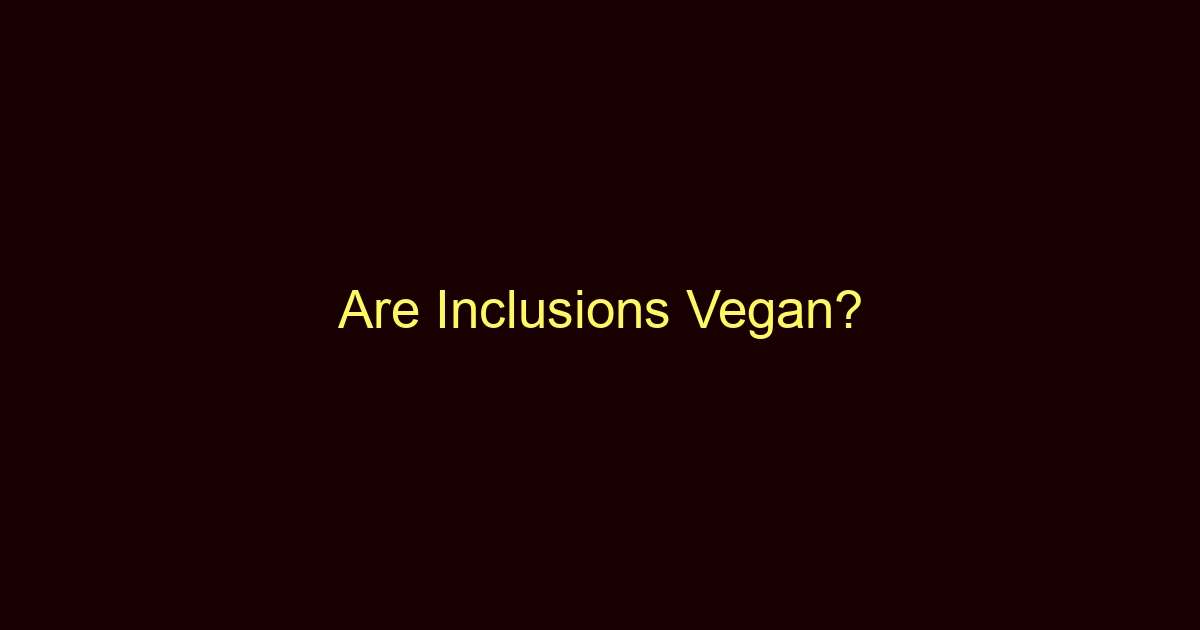In the world of food, inclusions are the extra ingredients that are added to enhance a product’s flavor, texture, or aesthetic appeal. From chocolate chips in your cookie to nuts in your granola bar, inclusions play a significant role in our culinary experiences. However, as consumers become more conscious about their dietary choices, one question frequently arises: are these inclusions vegan? Let’s dive into this intriguing subject.
What Are Inclusions?
Inclusions are the additional ingredients that are mixed into a food product to make it more flavorful, textural, or visually appealing. They are commonly used in a wide variety of foods ranging from baked goods to ice creams, chocolates, yogurts, and even savory dishes. The goal of these add-ons is to enrich the eating experience and offer a surprise element to the consumers.
Inclusions aren’t just a culinary trend. They reflect an understanding of food science, an appreciation for texture and flavor contrast, and a desire to create a multi-dimensional eating experience. However, understanding what inclusions are is only the tip of the iceberg. A deeper question remains: what are inclusions made of?
What Are Inclusions Made Of?
The composition of inclusions can widely vary depending on the type of food product and the sensory experience intended for the consumer. Some of the most commonly used inclusions are chocolate chips, nuts, dried fruits, cookie chunks, caramel pieces, sprinkles, and even savory inclusions like cheese, herbs, spices, and vegetables.
These inclusions are made from a broad spectrum of ingredients. For instance, chocolate chips are made from cocoa, sugar, and often milk, whereas dried fruits are dehydrated versions of the fresh fruit. Each inclusion comes with its own set of ingredients and process of creation, so it’s important to be aware of what goes into the inclusions of the foods you consume.
What Are Inclusions Used For?
The use of inclusions goes beyond just adding flavor to a food product. They contribute to the product’s texture, appearance, and overall sensory appeal. Inclusions can turn a plain cookie into a chunky, exciting treat, or transform a simple yogurt into a fun, fruity delight. They also play a role in enhancing the nutritional profile of the food, such as nuts adding healthy fats and proteins.
What Foods Contain Inclusions?
Inclusions are widely used across various food categories. Baked goods like cookies, muffins, and bread often contain chocolate chips, nuts, dried fruits, or seeds. Ice cream and yogurts are known for their swirls, chunks, and sprinkles. Savory foods like breads, pastas, and even ready-to-eat meals might have cheese, vegetable, or meat inclusions.
Are Inclusions Vegan?
The answer to whether inclusions are vegan or not is: it depends. Some inclusions, like nuts, seeds, and fruits, are naturally vegan. However, others like chocolate chips, cookie dough, and certain types of sprinkles may contain animal-derived ingredients like milk, eggs, or gelatin.
For example, chocolate chips often contain milk, making them non-vegan. However, dark chocolate chips or specific vegan-friendly brands offer alternatives. Similarly, cookie dough inclusions might contain butter and eggs, but vegan versions can be made using plant-based substitutes.
Can Vegans Eat Inclusions and Why?
Vegans can eat inclusions as long as they are made from plant-based ingredients and don’t contain any animal-derived components. Many food brands now provide vegan-friendly inclusions, such as dairy-free chocolate chips, plant-based cookie dough, and gelatin-free sprinkles.
It’s crucial to always check the ingredients list for potential animal-derived ingredients. The reason vegans can eat these plant-based inclusions is simple: they are made without causing harm to animals, aligning with the core principle of veganism.
Vegan Alternatives for Inclusions
There are numerous vegan alternatives available for traditionally non-vegan inclusions. Instead of regular chocolate chips, vegans can opt for dark chocolate or specific dairy-free brands. Similarly, cookie dough can be made vegan-friendly by using plant-based milk and butter substitutes, and replacing eggs with alternatives like flaxseed or applesauce.
Nuts, seeds, and dried fruits are naturally vegan and make excellent inclusions for a variety of food products. For savory dishes, vegan cheese, vegetables, and plant-based meats can be used. The possibilities for vegan inclusions are vast and continually expanding.
Role of Inclusions in a Balanced Diet
While inclusions add flavor and texture to food, they should be enjoyed as part of a balanced diet. Natural inclusions like nuts and fruits add beneficial nutrients to your meals. However, inclusions like chocolate chips and cookie dough are often high in sugar and should be consumed in moderation.
Furthermore, it’s important to remember that just because an inclusion is vegan, it doesn’t necessarily mean it’s healthy. Many vegan inclusions can still be high in sugar, unhealthy fats, or artificial additives. Always aim to choose whole, natural, and minimally processed inclusions when possible.
Is It Safe to Consume Inclusions?
Generally, it’s safe to consume inclusions as part of a balanced diet. However, it’s important to be aware of potential allergens. Many inclusions, such as nuts, dairy, and wheat, are common allergens. Always check the ingredients if you have any food allergies or intolerances.
For those following specific diets, like veganism or gluten-free, it’s equally important to check the ingredients of inclusions to ensure they meet your dietary needs. As always, moderation is key. Even healthy inclusions can lead to excess calorie consumption if not controlled.
Final Thoughts
The vegan status of inclusions depends entirely on their ingredients. While many are naturally vegan, like fruits, nuts, and seeds, others may contain animal-derived components. Thankfully, the rise in plant-based eating has encouraged food manufacturers to offer vegan alternatives for popular inclusions.
As a conscious consumer, it’s essential to read food labels and understand what you’re eating. While vegan inclusions can certainly be part of a delicious and diverse vegan diet, remember that they should be consumed as part of a balanced diet, and not all vegan inclusions are necessarily healthy.

